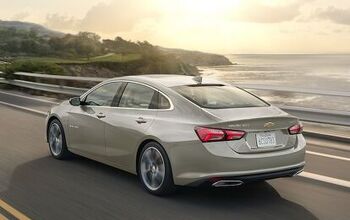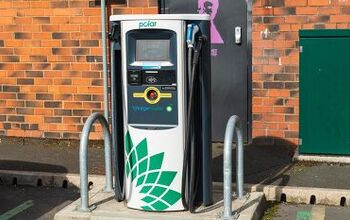Mazda: "Impending Death of the Internal Combustion Is Overrated"
If you were among America’s 1.4 million new vehicle buyers in July 2017, there’s a 99-percent chance your new vehicle requires fuel. Although the vehicles that run off the electric grid are linked to $7,500 government tax credits, they form barely more than half of one percent of the U.S. new vehicle market.
Mazda, you’ll recall, doesn’t sell any electric vehicles in the United States. Mazda doesn’t sell any vehicles with a plug. Mazda doesn’t even sell any hybrids.
So it’s not surprising that Robert Davis, former Mazda USA senior vice president of operations who’s now in charge of special assignments, candidly laid out the case for the internal combustion engine yesterday at the CAR Management Briefing seminars in Traverse City, Michigan.
“The internal combustion engine has a strong future role in transportation,” Robert Davis says.
Automotive News reports that Davis believes the “impending death of the internal combustion engine is overrated.”
“Let the government keep the $7,500,” Davis says, speaking of the EV tax credit, “and let the industry find the best way to meet the clean air standard. Make it CO2, make it grams per mile, fuel economy — whatever feels best. But don’t mandate the particular powertrain.”
Naturally, Mazda is deeply invested in the way regulatory environments approach the conventional internal combustion engine. As a small automaker hoping to earn a modest 2 percent share of the U.S. vehicle market — Mazda’s at 1.7 percent in 2017’s first-half — Mazda doesn’t have the wherewithal to quickly launch a dedicated EV or engineer a plug-in hybrid from the ground up.
Nor does Mazda seem terribly interested in doing so, anyway. “Making a couple of superefficient models,” Davis says in reference to vehicles such as the Fiat 500e, “to offset others really doesn’t make sense to us at Mazda.”
“We just don’t build cars that way.”
Davis says, “We certainly considered the adoption of new technologies, batteries, EVs, plug-in hybrids and everything else.” But with ICE at the foundation, “before we go into the time and effort and expense of adding electrification, we were convinced that a solid, efficient internal combustion engine was critical.”
Hence, Skyactiv branding is all up on e’erything.
Mazda’s Kenichiro Saruwatari said last month that the internal combustion engine was going to be a part of Mazda’s portfolio beyond 2050. Depending on your perspective, Mazda is either planting its head in the sand, swimming against the tide, or simply realistic about the size of the wave.
Mazda’s engine formula is set to change later this year with the arrival of a high-torque four-cylinder diesel in the 2018 CX-5. Hopefully news of its impending arrival is not overrated, as well.
[Image: Mazda]
Timothy Cain is a contributing analyst at The Truth About Cars and Autofocus.ca and the founder and former editor of GoodCarBadCar.net. Follow on Twitter @timcaincars.
More by Timothy Cain
Latest Car Reviews
Read moreLatest Product Reviews
Read moreRecent Comments
- Whynotaztec Like any other lease offer it makes sense to compare it to a purchase and see where you end up. The math isn’t all that hard and sometimes a lease can make sense, sometimes it can’t. the tough part with EVs now is where is the residual or trade in value going to be in 3 years?
- Rick T. "If your driving conditions include near-freezing temps for a few months of the year, seek out a set of all-seasons. But if sunshine is frequent and the spectre of 60F weather strikes fear into the hearts of your neighbourhood, all-seasons could be a great choice." So all-seasons it is, apparently!
- 1995 SC Should anyone here get a wild hair and buy this I have the 500 dollar tool you need to bleed the rear brakes if you have to crack open the ABS. Given the state you will. I love these cars (obviously) but trust me, as an owner you will be miles ahead to shell out for one that was maintained. But properly sorted these things will devour highway miles and that 4.6 will run forever and should be way less of a diva than my blown 3.8 equipped one. (and forget the NA 3.8...140HP was no match for this car).As an aside, if you drive this you will instantly realize how ergonomically bad modern cars are.These wheels look like the 17's you could get on a Fox Body Cobra R. I've always had it in the back of my mind to get a set in the right bolt pattern so I could upgrade the brakes but I just don't want to mess up the ride. If that was too much to read, from someone intamately familiar with MN-12's, skip this one. The ground effects alone make it worth a pass. They are not esecially easy to work on either.
- Macca This one definitely brings back memories - my dad was a Ford-guy through the '80s and into the '90s, and my family had two MN12 vehicles, a '93 Thunderbird LX (maroon over gray) purchased for my mom around 1995 and an '89 Cougar LS (white over red velour, digital dash) for my brother's second car acquired a year or so later. The Essex V6's 140 hp was wholly inadequate for the ~3,600 lb car, but the look of the T-Bird seemed fairly exotic at the time in a small Midwest town. This was of course pre-modern internet days and we had no idea of the Essex head gasket woes held in store for both cars.The first to grenade was my bro's Cougar, circa 1997. My dad found a crate 3.8L and a local mechanic replaced it - though the new engine never felt quite right (rough idle). I remember expecting something miraculous from the new engine and then realizing that it was substandard even when new. Shortly thereafter my dad replaced the Thunderbird for my mom and took the Cougar for a new highway commute, giving my brother the Thunderbird. Not long after, the T-Bird's 3.8L V6 also suffered from head gasket failure which spelled its demise again under my brother's ownership. The stately Cougar was sold to a family member and it suffered the same head gasket fate with about 60,000 miles on the new engine.Combine this with multiple first-gen Taurus transmission issues and a lemon '86 Aerostar and my dad's brand loyalty came to an end in the late '90s with his purchase of a fourth-gen Maxima. I saw a mid-90s Thunderbird the other day for the first time in ages and it's still a fairly handsome design. Shame the mechanicals were such a letdown.
- FreedMike It's a little rough...😄



































Comments
Join the conversation
The interesting thing is, given the fact that Mazda is really, really good at lightweight construction techniques, it'd seem to be a natural for electrified vehicles. Tells me they don't have the resources to play in that sandbox.
In late, but I have to agree with Mazda here, unless mandated by government forces, electrics have forever to go and are nowhere around the corner in any sort of massive market share kinda way. I actually just saw an analysis done on "fueling" an electric at home in San Diego using electrical consumption of the (I think Leaf), and the cost of tiered electrical rates currently in place in San Diego. It came to basically something like $6+ dollars in electricity for the same distance that a gas car can go for something like $2.50. When you're looking at 2-3x the cost for electrics in "fuel" alone, not to mention the added up-front expense (on some models), general smaller size, the government handouts, slow refueling, potential battery issues longer term etc etc, no rational person will ever choose an electric. Granted people don't act rationally all the time (minivans vs 3 row SUVs etc), but to see any sort of significant market penetration electrics have a boatload of hurdles to overcome. Most people will look at those downsides and pass. There won't be enough electric enthusiasts, or Tesla enthusiasts to make a dent anywhere. Mazda is being completely rational here.